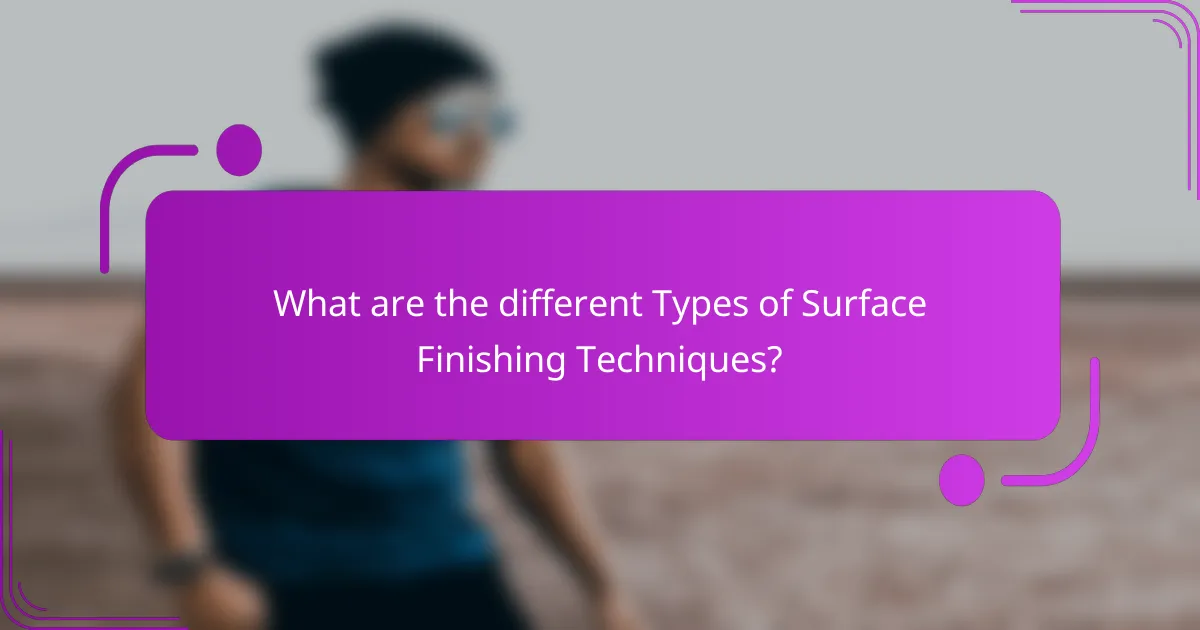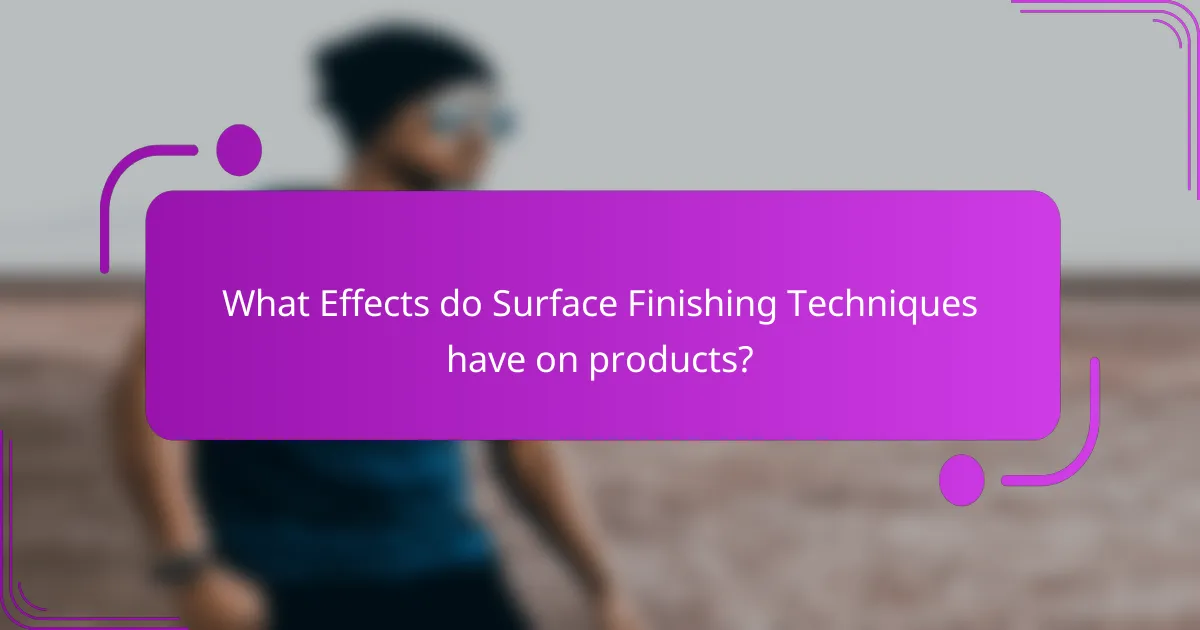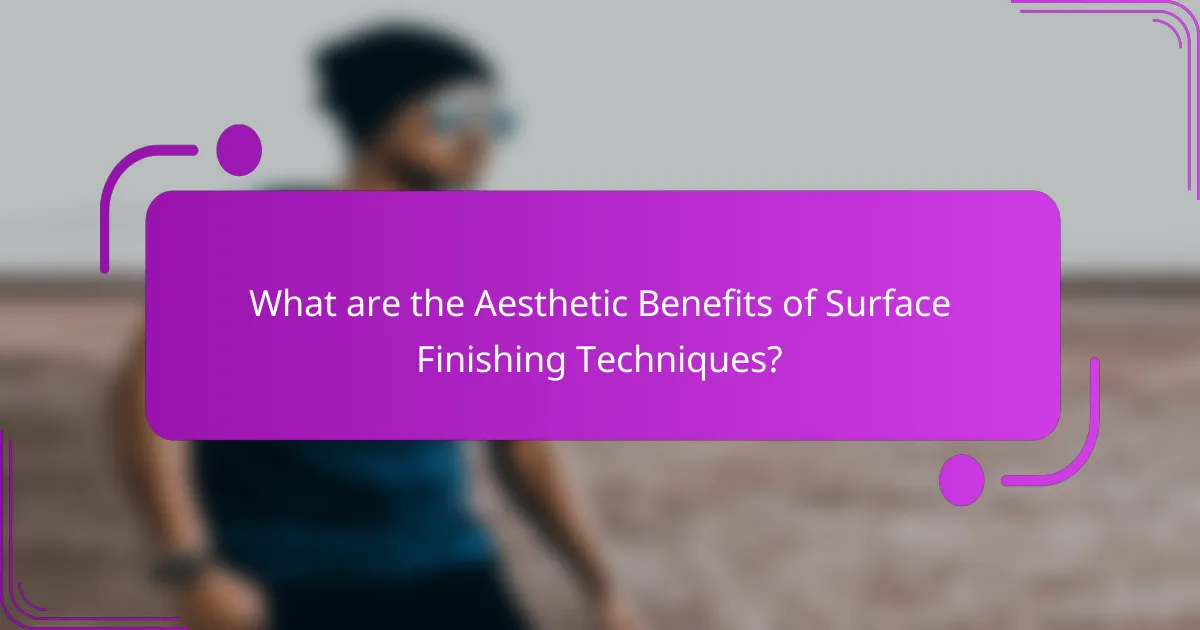Surface finishing techniques are methods employed to modify the surface characteristics of materials, enhancing their appearance, corrosion resistance, and wear resistance. Key techniques include polishing, grinding, buffing, coating, and plating, each serving distinct purposes in manufacturing. These processes not only improve surface smoothness and durability but also contribute to the aesthetic appeal of products, making them more attractive to consumers. The article explores the various types of surface finishing techniques, their effects on product performance, and the significant aesthetic benefits that enhance marketability and brand perception.

What are Surface Finishing Techniques?
Surface finishing techniques are methods used to alter the surface of a material. These techniques improve appearance, enhance corrosion resistance, and increase wear resistance. Common methods include polishing, grinding, and coating. Each technique has specific applications based on the material type and desired outcome. For example, polishing is often used for metals to achieve a shiny finish. Grinding is utilized for precision shaping and smoothing. Coatings can provide protective barriers against environmental factors. Overall, surface finishing techniques play a crucial role in manufacturing and product longevity.
How do Surface Finishing Techniques impact various materials?
Surface finishing techniques significantly impact various materials by enhancing their properties and aesthetics. These techniques improve surface smoothness, which can reduce friction and wear. For metals, processes like polishing and anodizing increase corrosion resistance. For plastics, techniques such as painting or coating enhance UV resistance and visual appeal. Wood finishing techniques, like staining and sealing, protect against moisture and improve durability. Each material responds differently; for example, glass polishing increases clarity and reduces brittleness. Overall, surface finishing techniques are essential for optimizing material performance and longevity.
What materials are commonly used in Surface Finishing Techniques?
Common materials used in surface finishing techniques include metals, plastics, and ceramics. Metals such as aluminum and stainless steel are widely utilized due to their durability and aesthetic appeal. Plastics like polycarbonate and acrylic are chosen for their lightweight properties and ease of molding. Ceramics, including porcelain and glass, are favored for their hardness and resistance to wear. Additionally, coatings such as paints, varnishes, and powder coatings are employed to enhance surface properties and appearance. These materials are selected based on their specific attributes, such as corrosion resistance, texture, and color retention, which are crucial for achieving desired finishing results.
How do different materials respond to various finishing techniques?
Different materials exhibit unique responses to various finishing techniques. Wood, for instance, absorbs stains and finishes differently based on its grain and porosity. Metals can be polished, anodized, or coated, affecting their appearance and corrosion resistance. Plastics respond well to sanding and spray finishes, which enhance their aesthetic appeal. Glass can be etched or frosted, altering its transparency and texture. Each material’s inherent properties dictate the effectiveness of the finishing technique applied. For example, hardwoods often yield a richer finish compared to softwoods due to their denser structure. Similarly, aluminum anodizing increases durability and surface hardness, demonstrating the specific benefits of tailored finishing methods.
Why are Surface Finishing Techniques important in manufacturing?
Surface finishing techniques are important in manufacturing because they enhance the performance and longevity of products. These techniques improve surface characteristics such as hardness, wear resistance, and corrosion resistance. For example, processes like anodizing can significantly increase the durability of aluminum components. Additionally, surface finishing can improve aesthetic qualities, making products more appealing to consumers. Consistent surface finishes can also ensure better adhesion of coatings and paints. According to a study published in the Journal of Materials Processing Technology, proper surface finishing can reduce manufacturing defects by up to 30%. This highlights the critical role these techniques play in improving overall product quality and reliability.
What role do Surface Finishing Techniques play in product durability?
Surface finishing techniques significantly enhance product durability. These techniques improve resistance to wear, corrosion, and environmental factors. For instance, coatings like anodizing or powder coating create a protective layer. This layer prevents oxidation and extends the lifespan of metal products. Additionally, surface treatments like polishing can reduce friction. Lower friction minimizes wear during use. Research shows that properly finished surfaces can last up to five times longer than untreated ones. Therefore, surface finishing is essential for ensuring long-lasting and reliable products.
How do Surface Finishing Techniques enhance product performance?
Surface finishing techniques enhance product performance by improving durability, reducing friction, and increasing resistance to corrosion. These techniques include polishing, coating, and plating. For example, polishing creates a smoother surface, which minimizes wear and tear. Coatings can provide a protective barrier against environmental factors. Plating adds a layer of metal that improves strength and aesthetic appeal. According to a study published in the Journal of Materials Science, surface treatments can increase the lifespan of components by up to 50%. Enhanced performance leads to greater efficiency and longevity in various applications.

What are the different Types of Surface Finishing Techniques?
The different types of surface finishing techniques include polishing, grinding, buffing, coating, and plating. Polishing enhances surface smoothness and shine. Grinding removes material to achieve desired dimensions and surface quality. Buffing further refines surfaces, often using a soft cloth to create a gloss. Coating involves applying a protective layer to improve durability and aesthetics. Plating adds a metal layer for protection or decorative purposes. Each technique serves specific purposes in manufacturing and enhances the final product’s appearance and performance.
What are the main categories of Surface Finishing Techniques?
The main categories of surface finishing techniques are mechanical, chemical, and thermal processes. Mechanical processes include grinding, sanding, and polishing. These techniques physically alter the surface to achieve desired smoothness or texture. Chemical processes involve treatments like anodizing, electroplating, and passivation. These methods modify the surface at a molecular level for corrosion resistance or aesthetic appeal. Thermal processes include methods such as heat treatment and laser finishing. These techniques utilize heat to enhance material properties or surface characteristics. Each category serves specific purposes in improving durability, functionality, and appearance.
How do mechanical finishing techniques differ from chemical finishing techniques?
Mechanical finishing techniques involve physical processes to alter a surface’s texture and appearance. These techniques include grinding, polishing, and sanding. They primarily rely on tools and equipment to achieve the desired finish. In contrast, chemical finishing techniques use chemical reactions to modify surface properties. Examples include anodizing, electroplating, and chemical passivation. Mechanical methods often enhance surface smoothness and dimensional accuracy. Chemical methods can improve corrosion resistance and alter surface chemistry. Each technique serves different purposes in manufacturing and surface treatment. Mechanical finishing is typically faster, while chemical finishing can provide more durable results.
What are the advantages of using thermal finishing techniques?
Thermal finishing techniques provide several advantages in enhancing material properties. These techniques improve the durability and strength of materials through controlled heating processes. They can also enhance surface smoothness, leading to better aesthetic appeal. Additionally, thermal finishing can reduce residual stresses in materials, which minimizes the risk of deformation. This process often results in improved corrosion resistance, extending the lifespan of products. Furthermore, thermal finishing techniques can be tailored to specific materials, making them versatile for various applications. Overall, these advantages contribute to higher quality and performance in finished products.
What are some specific examples of Surface Finishing Techniques?
Examples of surface finishing techniques include polishing, plating, and anodizing. Polishing enhances surface smoothness and shine. It is commonly used on metals to improve appearance and reduce friction. Plating involves coating a surface with a layer of metal. This technique can enhance corrosion resistance and aesthetic appeal. Anodizing is an electrochemical process that increases thickness of the natural oxide layer on metal surfaces. It provides better corrosion resistance and allows for dyeing in various colors. Other techniques include sandblasting, which creates a textured finish, and powder coating, which offers durable color finishes. Each technique serves specific applications in manufacturing and design.
What is the process of polishing and how does it benefit surfaces?
Polishing is a surface finishing process that enhances the smoothness and shine of materials. It involves using abrasives or polishing compounds to remove imperfections and achieve a reflective surface. The process can be performed mechanically or manually, depending on the material and desired finish.
Benefits of polishing include improved aesthetics, which enhances the visual appeal of surfaces. Polished surfaces are easier to clean and maintain, reducing the accumulation of dirt and grime. Additionally, polishing can increase the durability of materials by creating a protective layer. This process also reduces friction, which can extend the lifespan of components in mechanical applications.
Overall, polishing is essential for achieving high-quality finishes in various industries, including automotive, manufacturing, and woodworking.
How does anodizing improve the properties of metals?
Anodizing improves the properties of metals by creating a protective oxide layer on the surface. This layer enhances corrosion resistance significantly. For example, anodized aluminum can withstand harsh environments better than untreated aluminum. Anodizing also increases surface hardness, making metals more durable. The process can improve wear resistance, which is crucial for parts in high-friction applications. Additionally, anodizing allows for better adhesion of paints and adhesives. The resulting finish can be aesthetically pleasing, available in various colors. Overall, anodizing enhances both functional and aesthetic qualities of metals.

What Effects do Surface Finishing Techniques have on products?
Surface finishing techniques significantly enhance product performance and aesthetics. These techniques improve surface smoothness, which reduces friction and wear. For example, polished surfaces often exhibit better corrosion resistance. Additionally, surface finishing can enhance adhesion for coatings and paints. Techniques like anodizing can increase durability in metal products. Furthermore, finishing techniques contribute to the visual appeal of products. A well-finished surface can attract consumers and elevate brand perception. Overall, the effects of surface finishing techniques are crucial for product longevity and marketability.
How do Surface Finishing Techniques influence the aesthetic appeal of products?
Surface finishing techniques significantly enhance the aesthetic appeal of products. These techniques improve visual characteristics such as texture, color, and shine. A polished surface reflects light, creating a more attractive appearance. Techniques like anodizing can add vibrant colors to metal surfaces. Additionally, surface treatments can create unique patterns or textures, adding depth to the design. For instance, sandblasting produces a matte finish that can evoke a modern aesthetic. Research indicates that consumers often associate high-quality finishes with superior product quality. Thus, effective surface finishing contributes to perceived value and marketability.
What visual characteristics are enhanced through Surface Finishing Techniques?
Surface finishing techniques enhance several visual characteristics. These include glossiness, texture, color depth, and uniformity. Glossiness refers to the reflective quality of a surface. Higher gloss levels create a shiny appearance, which can enhance visual appeal. Texture modifications can create patterns or smoothness, affecting how light interacts with the surface. Color depth is improved through techniques that enrich hues and saturation, making colors appear more vibrant. Uniformity ensures a consistent appearance across the surface, eliminating imperfections. These enhancements contribute significantly to the aesthetic value of finished products.
How do Surface Finishing Techniques affect the tactile experience of products?
Surface finishing techniques significantly influence the tactile experience of products. These techniques alter the texture, smoothness, and overall feel of a product’s surface. For instance, polishing creates a smooth surface that enhances touch comfort. Conversely, sandblasting produces a rough texture that can provide grip. Different finishes can evoke various sensory responses. A matte finish may feel softer and less slippery, while a glossy finish can feel sleek and modern. Research indicates that tactile experiences affect consumer perception and satisfaction. A study by Pecher et al. (2013) demonstrates that texture influences product evaluation. Thus, surface finishing techniques are crucial in shaping tactile interactions with products.
What are the environmental effects of Surface Finishing Techniques?
Surface finishing techniques can have significant environmental effects. These methods often involve the use of chemicals and solvents that may release harmful substances into the air and water. For instance, electroplating can produce toxic wastewater containing heavy metals. Additionally, processes like sandblasting can generate particulate matter that contributes to air pollution. The disposal of waste materials from these techniques can lead to soil contamination if not managed properly. The use of volatile organic compounds (VOCs) in certain finishing processes can also contribute to ozone depletion. Thus, the environmental impact of surface finishing techniques necessitates careful regulation and sustainable practices.
How can Surface Finishing Techniques contribute to sustainability?
Surface finishing techniques can contribute to sustainability by reducing waste and enhancing material longevity. These techniques improve the durability of products, leading to less frequent replacements. For example, processes like anodizing and powder coating can protect metals from corrosion. This protection extends the lifespan of products, minimizing resource consumption over time. Additionally, eco-friendly finishing options use fewer harmful chemicals, reducing environmental impact. Research shows that sustainable surface finishing can lower energy consumption during production. By adopting these techniques, industries can promote a circular economy and reduce their carbon footprint.
What are the common environmental concerns associated with these techniques?
Common environmental concerns associated with surface finishing techniques include chemical waste and air pollution. Many surface finishing processes utilize harmful chemicals that can contaminate soil and water. For example, solvents used in paint and coating applications can emit volatile organic compounds (VOCs), contributing to air quality issues. Additionally, improper disposal of waste from these techniques can lead to hazardous environmental impacts. Studies indicate that industrial surface finishing can generate significant amounts of waste, necessitating stringent regulations to mitigate risks.

What are the Aesthetic Benefits of Surface Finishing Techniques?
Surface finishing techniques enhance the visual appeal of materials. They improve surface texture, leading to a more polished and refined look. Techniques like polishing and anodizing create a smooth, shiny surface. This can elevate the perceived quality of products. Additionally, surface finishes can add color and design elements. Treatments such as powder coating provide vibrant colors and patterns. These enhancements can attract consumers and increase market value. Overall, aesthetic benefits contribute significantly to product differentiation in competitive markets.
How do Surface Finishing Techniques improve product design?
Surface finishing techniques enhance product design by improving aesthetics, functionality, and durability. These techniques include polishing, coating, and texturing. Aesthetic improvements attract consumers and elevate brand perception. Functional enhancements can reduce friction and increase corrosion resistance. Durability extends the product’s lifespan and reduces maintenance needs. For instance, anodizing aluminum not only provides a decorative finish but also increases corrosion resistance. According to a study by the American Society of Mechanical Engineers, surface finishing can improve wear resistance by up to 50%. Therefore, integrating surface finishing techniques is crucial for optimizing product design.
What role does surface texture play in product aesthetics?
Surface texture significantly influences product aesthetics by affecting visual appeal and tactile experience. The texture can enhance or detract from a product’s perceived quality. Different textures can evoke various emotional responses. For example, smooth surfaces often convey elegance and modernity. Conversely, rough textures may suggest ruggedness or authenticity. Research shows that consumers often associate specific textures with brand identity. A study published in the Journal of Consumer Research found that texture impacts consumer preferences and purchasing decisions. Therefore, surface texture plays a crucial role in shaping the overall aesthetic perception of a product.
How do color and finish choices impact consumer perception?
Color and finish choices significantly influence consumer perception. The color of a product can evoke emotions and associations. For example, blue often conveys trust and reliability. Bright colors can attract attention and create excitement. Finish choices, such as matte or glossy, affect perceived quality. Glossy finishes may suggest modernity and luxury. Matte finishes can imply subtlety and sophistication. Research indicates that 85% of consumers make purchasing decisions based on color. Additionally, the right color and finish can enhance brand identity and recognition. Thus, effective color and finish strategies are crucial for appealing to target audiences.
What best practices should be followed for effective Surface Finishing?
Effective surface finishing requires several best practices. First, proper surface preparation is essential. This includes cleaning, degreasing, and removing any oxidation. Second, selecting the right finishing technique is crucial. Techniques such as grinding, polishing, or coating should match the material and desired finish. Third, maintaining consistent parameters during the finishing process is vital. Factors like speed, pressure, and temperature must be monitored. Fourth, using high-quality tools and materials enhances the finishing outcome. Poor-quality products can lead to defects. Fifth, conducting regular maintenance on equipment ensures optimal performance. Lastly, quality control checks should be implemented throughout the process. This verifies that the surface meets the required specifications. Following these practices leads to improved durability and aesthetics in surface finishing.
How can manufacturers choose the right Surface Finishing Technique for their needs?
Manufacturers can choose the right surface finishing technique by assessing their specific requirements. They should consider the material type, desired aesthetic, and functional properties. Surface finishing techniques include polishing, painting, and anodizing. Each technique offers unique benefits. For example, polishing enhances surface smoothness and gloss. Painting provides color and corrosion resistance. Anodizing increases durability for aluminum products. Manufacturers should also evaluate production volume and cost-effectiveness. Performance specifications and industry standards can guide their decision. Ultimately, the right technique aligns with product requirements and enhances overall quality.
What common mistakes should be avoided in Surface Finishing processes?
Common mistakes to avoid in surface finishing processes include inadequate surface preparation. Poor cleaning can lead to contamination and defects. Another mistake is using incorrect finishing materials. This can result in poor adhesion and durability. Overlooking environmental conditions is also critical. Humidity and temperature can affect the finishing quality. Additionally, improper application techniques can create uneven surfaces. Not following manufacturer guidelines can lead to suboptimal results. Lastly, neglecting to perform quality checks can result in unnoticed flaws.
Surface finishing techniques are essential methods used to modify the surface of materials, enhancing their appearance, durability, and performance. This article explores various types of surface finishing techniques, including mechanical, chemical, and thermal processes, and their impact on different materials such as metals, plastics, and ceramics. It also highlights the aesthetic benefits of these techniques, discussing how they improve visual appeal and tactile experiences, while addressing environmental concerns and best practices for effective implementation. Understanding these aspects is crucial for manufacturers seeking to optimize product quality and longevity.